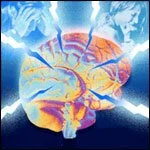Video games might cause aggressive behavior,1 and they may contribute to childhood obesity,2 but recent research by Daphne Bavelier and her colleagues at the University of Rochester suggests that playing video games can have at least one benefit: they enhance visual attention
Visual attention is the mental mechanism we use to select relevant visual information and suppress irrelevant information in our visual field. This ability is particularly important during activities that require selective focus amidst an overwhelming amount of incoming visual material. Driving a car or flying an airplane are two such circumstances . . . as is playing a video game.
In action-packed video games such as Halo or Call of Duty, players must aim and shoot accurately while simultaneously tracking enemies and other rapidly moving objects—thus emphasizing visual attention. In studies comparing the visual attention of gamers and non-gamers, Bavelier and her colleagues found that gamers consistently outperformed non-gamers.3 Furthermore, non-gamers who practiced playing video games demonstrated improved visual attention. This means that playing the video games increased gamers’ visual attention (as opposed to the alternative possibility that people with superior visual attention tend to play video games).
The implications of this research are important in both medicine and the military. EyeMario, a system developed by National Labs, is a vision-controlled video game that is being used to treat amblyopic patients. Amblyopia, or “lazy eye,” is treated by forcing the patient to exercise their lazy eye, often by patching the healthy one. Video games such as EyeMario work as “eye exercises”: sensors attached to the player’s face detect retinal movements and use these to control the character Mario’s actions in the game.
In addition to helping patients with visual deficits, Bavelier and her colleagues suggested in their review that fighter pilots would benefit greatly from enhanced visual attention. In 2008, the U.S. Army invested $50 million over 5 years to develop games and gaming systems to train soldiers, and the Program Executive Office for Stimulation, Training, & Instrumentation (PEO-STRI) has already developed the Additional Blackhawk Flight Simulator—amongst other programs—to help train army pilots.
Read Bavelier et al.’s research in WIREs Cognitive Science.
Watch a demonstration of EyeMario.
Find more PEO-STRI programs.
| Resources from Wiley on This Topic | |

|
Computer Assisted Exercises and Training: A Reference Guide
by Erdal Cayirci and Dusan Marincic |
1. Anderson, C., & Carnagey, N. (2009). Causal effects of violent sports video games on aggression: Is it competitiveness or violent content? Journal of Experimental Social Psychology, 45 (4), 731-739 DOI: 10.1016/j.jesp.2009.04.019
2. Vandewater EA, Shim MS, & Caplovitz AG (2004). Linking obesity and activity level with children’s television and video game use. Journal of adolescence, 27 (1), 71-85 PMID: 15013261
3. Hubert-Wallander, B., Green, C., & Bavelier, D. (2010). Stretching the limits of visual attention: the case of action video games Wiley Interdisciplinary Reviews: Cognitive Science DOI: 10.1002/wcs.116
 Corticotropin-releasing factor (CRF) is a neurotransmitter that is released due to stress and binds to neurons in the locus ceruleus, the “alarm center” of the brainstem. CRF’s ability to set off “alarms” in this area of the brain (that is, to stimulate neurons) is affected by:
Corticotropin-releasing factor (CRF) is a neurotransmitter that is released due to stress and binds to neurons in the locus ceruleus, the “alarm center” of the brainstem. CRF’s ability to set off “alarms” in this area of the brain (that is, to stimulate neurons) is affected by:

